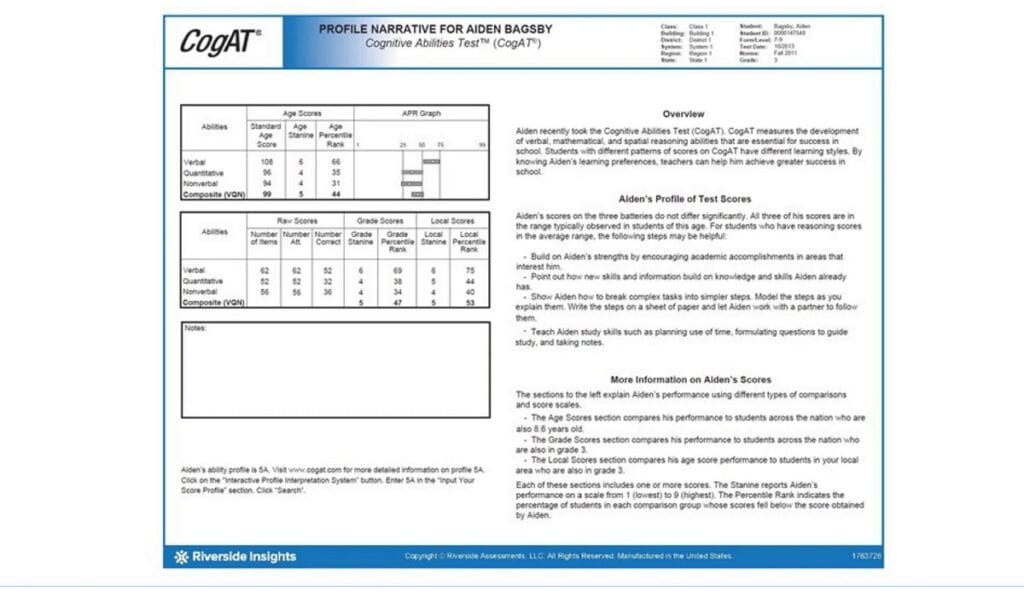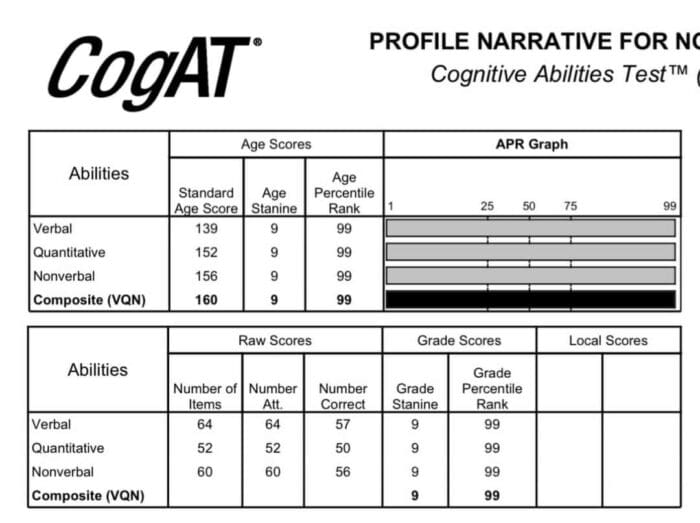CogAT scores provide valuable information about your child’s cognitive strengths and abilities.
This guide breaks down the scoring system, covering Raw Scores, Composite Scores, and Ability Profiles, to help you understand what the numbers mean.
Learn how the Verbal, Quantitative, and Nonverbal sections are scored and discover ways to use this information to support your child’s academic progress.
With clear explanations and actionable tips, this guide makes understanding Cognitive Abilities Test scores simple and effective.

Hey there! Do you have a question about the test or our practice package? Email me at roman@staggingapps.website. I'm here to help your child succeed!
Test results provide insights into your child’s cognitive abilities and help guide educational planning. Many schools use these results to identify students for advanced learning programs, ensuring they receive appropriate challenges and support.
Understanding profiles such as A, B, C, and E can reveal your child’s learning preferences, allowing you to adjust strategies to match their strengths.
These insights give you the tools to support your child’s academic progress and ensure their learning environment meets their needs.

Raw scores show the number of questions your child answered correctly on the CogAT. While they form the basis for all other scores, raw scores alone offer limited insight as they don’t consider question difficulty or the test-taker’s age.
To provide a clearer picture of performance, raw scores are transformed into standardized scores.
These standardized scores reveal different aspects of cognitive abilities.
Score Type | Description |
Universal Scale Score (USS) | The USS adjusts raw scores to a standardized scale across all age groups. It creates a consistent measure for comparing results among students of varying ages and grades. This score serves as the foundation for interpreting other score types. |
Standard Age Score (SAS) | The SAS is a widely used measure that adjusts the Universal Scale Score to a scale with an average of 100 and a standard deviation of 16. This score allows for easy comparison of a student’s cognitive abilities relative to peers of the same age. For instance, a score of 100 indicates average performance. Meanwhile, scores above or below 100 show how much a student’s abilities differ from the age-group average. |
Percentile Rank (PR) | The Percentile Rank converts the SAS into a percentage, showing how a student performed compared to others in the same age group. For example, a Percentile Rank of 85 means the student performed better than 85% of their peers. This metric offers a clear picture of relative performance and is helpful for parents and educators in assessing a student’s standing. |
Stanine Scores | Stanine scores simplify Percentile Ranks by grouping them into a 1-9 scale. A score of 5 represents average performance. Scores from 1 to 3 are below average, while scores from 7 to 9 are above average. This system provides a quick overview of performance without delving into detailed percentile data. |
Begin by reviewing the Standard Age Score (SAS), which measures performance on a scale with 100 as the average.
Next, examine the Percentile Rank (PR) to understand how your child performed compared to others in the same age group.
Finally, look at the Stanine Scores for a simplified view of whether your child’s abilities are below average, average, or above average.
The score profile offers insights into your child’s cognitive strengths and areas for improvement.
It reflects their overall performance and highlights patterns across the three test sections: Verbal, Quantitative, and Nonverbal.
Here’s what each profile reveals:
Profile | Description |
A | Consistent performance across all three sections, showing balanced cognitive abilities. |
B | One area stands out as stronger than the others, indicating a specific cognitive strength. |
C | Significant variability between section scores, revealing both strengths and weaknesses. |
E | Extreme differences between the highest and lowest scores, suggesting notable challenges or exceptional abilities. |
A “good” score depends on your goals and context. An SAS of 100 represents average performance, while scores above 115 are typically considered above average and may qualify your child for advanced learning programs.
The definition of a “good” score can vary based on your child’s needs and the requirements of specific programs.
Here is an example of a score report of a 9A CogAT profile, which is the highest CogAT profile:
The Percentile Rank (PR) shows how your child performed compared to others in their age group. For instance, a PR of 90 means your child scored better than 90% of their peers.
You can’t calculate your child’s scores on your own. The scoring process relies on proprietary algorithms and standardized data that only the testing provider can access.
After the test, the school or testing center will give you a detailed score report. This report includes the Standard Age Score (SAS), Percentile Rank (PR), and Stanine Scores, along with explanations to help you understand the results.
While you can’t do the calculations yourself, you can use the report to gain valuable insights into your child’s performance and cognitive abilities.
A child’s stage of cognitive development plays a key role in their test performance. As children grow, their reasoning, problem-solving, and information-processing skills improve, which affects their scores.
Younger children, still developing these abilities, may score differently from older children with similar potential. This is why it’s essential to view scores in the context of a child’s age and developmental stage.
Recognizing these factors allows parents and educators to set appropriate expectations and make better decisions about a child’s educational needs.
Children from diverse cultural and socioeconomic backgrounds may have different levels of familiarity with the test content or environment. This can impact their performance.
When interpreting scores, it’s essential to consider these influences to ensure assessments are viewed fairly and accurately across all groups. This perspective helps provide a more equitable understanding of a child’s abilities.
Executive function skills, such as working memory, flexible thinking, and self-control, are key to performing well on the test. These skills help children manage tasks, shift between different types of thinking, and retain important information during the test.
Children with strong executive function skills often achieve higher scores. You can support your child by encouraging activities that improve memory, foster flexible thinking, and develop problem-solving strategies.
Strengthening these skills can not only boost test performance but also enhance overall cognitive abilities.
Improving your child’s performance starts with understanding the factors that influence their scores. By taking specific steps, you can strengthen their cognitive skills and test-taking abilities.

Practice tests are one of the most effective tools for preparing your child. They help familiarize your child with the test format, question types, and time constraints, building both confidence and skills.
In addition to practice tests, use question banks and instructional guides designed for the test. Online platforms and workbooks offer structured exercises to target specific areas for improvement.
Regular practice, especially with full-length tests, can significantly improve your child’s performance and support their academic growth.
Understanding CogAT scores offers valuable insights into your child’s cognitive strengths and areas for improvement.
By becoming familiar with key metrics like Raw Scores, Standard Age Scores (SAS), and Percentile Ranks (PR), you can better interpret the results and guide your child’s learning journey.
Consider how factors such as cognitive development, cultural background, and executive function influence performance. This knowledge allows you to make informed decisions about your child’s education and support their growth effectively.
As a parent, your role is essential in helping your child prepare for the CogAT. Use the strategies and resources shared here to build their confidence, strengthen their skills, and improve their test performance.

Sharpening your child's skills with lifelike practice for gifted tests and school exams.
© 2025 GiftedReady | HTML Sitemap